Modules are the main building blocks when you design your chatbot’s conversation flow. There are two different types of modules: Collector Modules and Statement Modules.
We'll focus on Collector Modules here, covering the following topics:
- Introduction to Collector Modules
- Understand the basic Module features
- Bot Error Messages of Collector Modules
- Types of Collector Modules
Introduction to Collector Modules
This smart type of bot response can be created by either:
- right-clicking your mouse, selecting Collector, and choosing the desired type; or
- by going to the right sidebar menu, selecting Collector, and choosing the desired type.
Collector Modules are great tools if you need to check or verify the visitor's input. Often, Collector Modules are used to ask the visitor for a certain type of information such as their email, order number, or telephone number. Once the visitor has provided the requested information, the bot validates whether the user input matches the format selected.
Understand the basic Module features
It's important to understand the basic features of a Module. See an overview of these here:
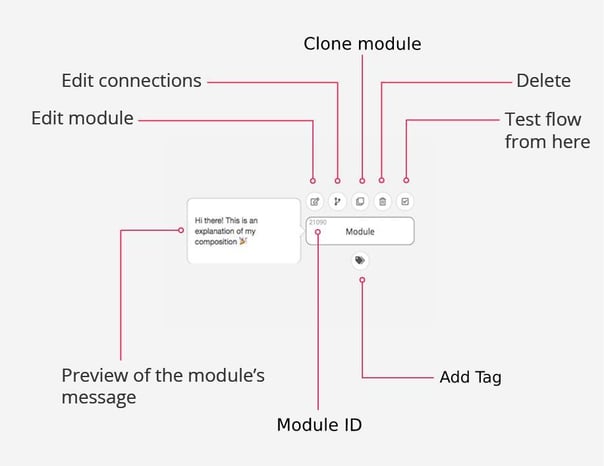
The key features are described in detail in our article on how to edit a Module.
Bot Error Messages of Collector Modules
The Bot Error Message of a Collector Module is an important feature that helps collect required information in a human-like manner. Assuming the visitor´s input cannot be verified, the bot can ask the visitor again for the required information.
If the visitor still does not provide the required information, another Bot Error Message, as defined by you, will be shown. You can insert as many Bot Error Messages as you think would be adequate in order to simulate a human conversational flow. Please note that the error messages are randomly displayed, not in order.
It is important to keep in mind that all Bot Error Message(s) you set up will be shown as options for use in any Collector Modules you are using. Select the appropriate Bot Error Message(s) for each module by ticking the checkbox for each message accordingly (you can see this in the example Multiple Choice Module image later in this article).
By default, the bot allows for 3 wrong insertions of data, then redirects to fallback. This can be changed in Bot Settings:
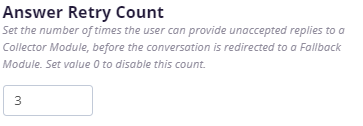
Types of Collector Modules
You can set up the Collector Module in accordance with the information you're requesting from the user.
In this section, you can read more about each of the following Module types:
Multiple Choice Module
Multiple Choice Collector Modules are similar to Statement Modules, as both module types can accept freely written text from a user, and both of them can have clickable answer options. Generally speaking, Multiple Choice Modules can be considered traditional bot messages, since these follow a keyword-based logic.
The difference between Multiple Choice Modules and Statement Modules
The difference between Statement Modules and Multiple Choice Modules is that Multiple Choice Modules have the Bot Error Messages feature built-in. This means if the visitor sends information that cannot be understood by the bot, a predefined error message will be sent.
It is important to note that when using Multiple Choice Modules, the conversation cannot continue without any visitor input, whereas this is possible when using Statement Modules.
How to set up a Multiple Choice Module
Using Multiple Choice Modules, a certain type of visitor input needs to be verified. This can be done by either adding Suggested replies or Connection options. If the visitor's input does not match the Suggested replies or Connection options, the bot error message will be shown. If no error message is defined, the designated fallback message is shown.
The difference between Suggested replies and Connection options is that Suggested Replies buttons are visible only for the last interaction and options buttons will stay in the chat history after each interaction.
The use case for Multiple Choice Modules
The most frequent use case for Multiple Choice Modules is if you require a predefined visitor input in order to continue the conversational flow.
In a very simplified example, if a bot only consists of conversational flows for product recommendations, product clarifications, and product suggestions, it is necessary to know which of the three options the visitor would like to learn more about. The visitor has simply no other options to choose from. Thus, if the visitor were not to click on any of the suggested responses as illustrated below, the conversation would end very quickly.
You can take a look at this example below:
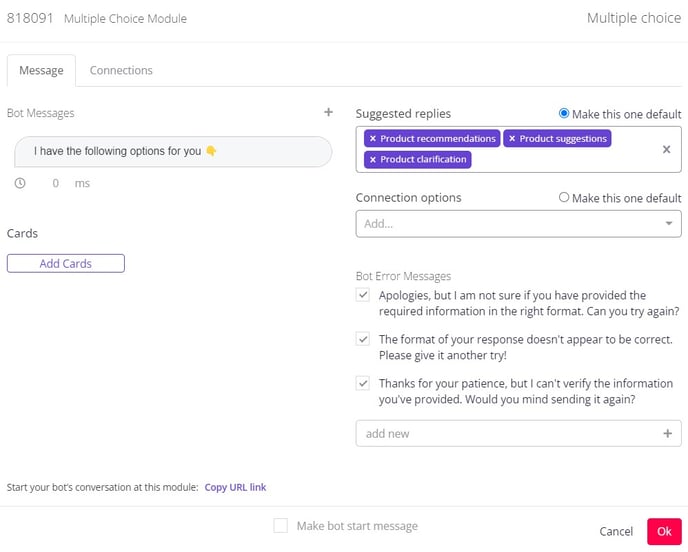
Email Module
The Email Collector Module is especially helpful if you would like to create leads during your conversational flows. You can use it to verify a user's email address, which is extremely valuable if the email address is the only contact detail you're collecting from your visitor.
Difference between verification of and collection of the email address
Using the Email Module, the email address will not be collected automatically. As described above, it is a tool to check the format of the email provided by the visitor.
If you would like to store the email address, go to the Connections tab of that Module and set a Custom Variable as, for instance, User_email.
View an example in our article on storing the end user reply in a Custom Variable.
The following image shows one possible setup of an Email Module:
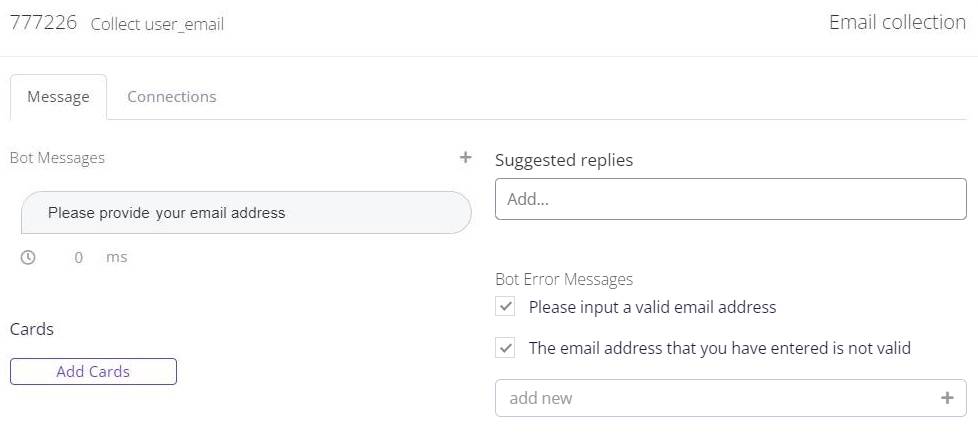
URL Module
URL Modules are very helpful to refer to, for example, support tickets on other platforms. As with all Collector Modules, the main benefit of their use lies in the ability to check the format of the visitor input. In this type, for instance, the module would verify if the visitor actually provided a URL.
Number Module
In many use cases, number rows serve as identifiers to understand the customer case better. A Number Module supports you in verifying unique, number-based IDs such as an order number, so you can ensure a valuable service experience for your customers.
As previously explained in the section on the Email Module, the Number Module does not store any information automatically, but only verifies whether the user input is comprised of numbers.
You are able to define how many numbers the row must contain. You can do so by typing in the desired restriction in the text box Number length. Take a look at the example below, where the user can only respond with a number row consisting of exactly 10 numbers.
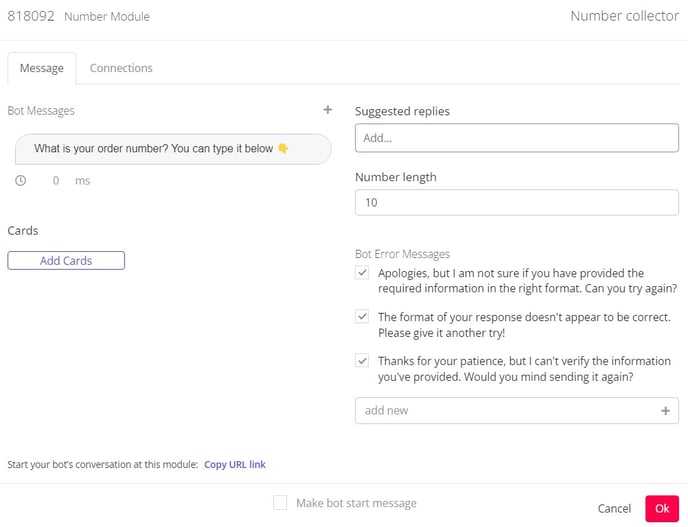
Phone Number Module
The Phone Number Module has a comparable setup to the Number Module. It reads the visitor information and checks if the format provided by the users matches the format of a phone number.
Again, the phone number will not be stored automatically when applying a Phone Number Module. Go to the Connections tab of that Module to set a Custom Variable as, for example, User_phone.
Learn more about storing the end user reply in a Custom Variable using Collector Modules.
Time & Date Module
The Time & Date Module validates whether or not your customer has input a date. Please note that the names of weekdays must be written out. To provide an example, "Wed" for "Wednesday" would not be understood by the bot.
We recommend specifying which date format you use in the Message for this module (dd-mm-yyyy). For example, a question for the customer could be phrased as follows: "When would you like to book a table at our restaurant? Please write the date (dd-mm-yyyy) and time (hh:mm am/pm)."
